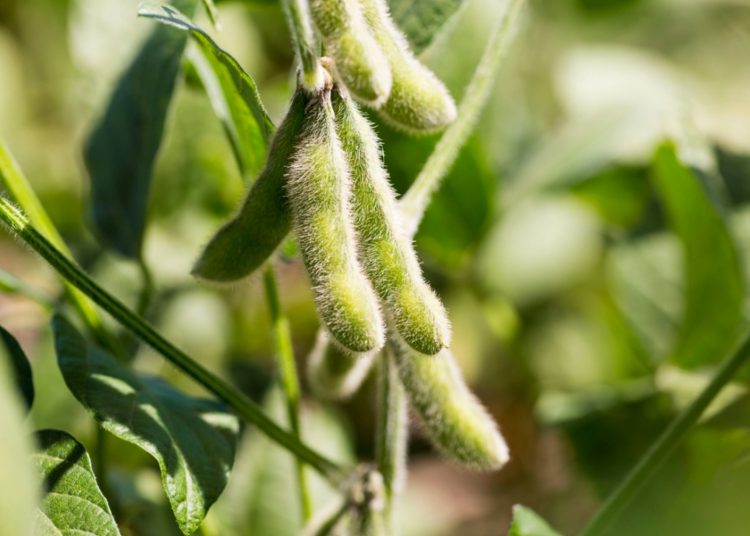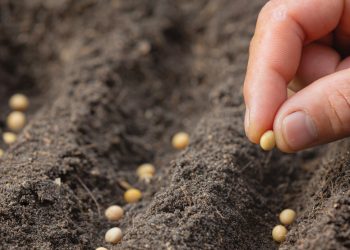The NWK Limited external factors report provides an overview of the main external factors that NWK and its clients are exposed to at a specific point in time. This report opts to aid in a timely basis to foresee external market and other factors that may have an impact on any business and clients. The main focus of this document is to have a closer look at external factors that can affect any business and our customers.
Executive summary
The Agribusiness Confidence Index for June (Q2), compiled by the Agricultural business chamber, presents a picture of a sector that is still on solid footing. The National Agricultural Marketing Council (NAMC) projected the ending stock for 30 April 2023 of white maize to be less than the 2021/2022 season. According to the sixth maize forecast the three main maize producing areas, namely the Free State, Mpumalanga and North West are expected to produce 82% of the 2022/2023 crop.
The latest increase of 75 basis points (bps) is the biggest hike since 2002. This is followed by a consumer inflation rate of 7,4%. The South African Reserve Bank made a number of interest rate cuts amounting to 300 bps to bring relief to the economy, but as from November 2021 the prime interest rate experienced five increases amounting to a total of 200 bps. The repo rate is currently 5,5% and the prime rate is 9%. Professor Raymond Parsons is of the opinion that given present global and domestic economic cross-currents, a more aggressive monetary policy raises the risk that it may well now come at a cost in growth and employment. He also mentions that there are external and internal reasons to expect that the inflation rate will decline towards the end of 2022.
The Russia-Ukraine conflict has a big impact on the global economy as these two countries are rich in minerals and key role-players in the export of oil, natural gasses, sunflower oil, palladium and fertiliser materials amongst others. With exports influenced the increasing demand for these resources cause prices to rise.
As from midnight, 6 September 2022, a decline in fuel prices will bring some relief to consumers with petrol experiencing the biggest price decline of R2,04 per litre.
Load shedding poses long term risks for the agricultural sector on a supply and input cost level. When producers struggle to produce outputs, NWK is directly impacted through less silo stock income and producers’ ability to repay loans. Cost effective and sustainable alternative solutions must be considered in order to reduce the dependency on Eskom for electricity.
Agbiz/IDC ACI moderates in Q2, 2022
Agbiz quarterly conducts a survey in order to create an Agribusiness Confidence Index (ACI). The Agbiz/IDC ACI, which was released on 13 June 2022, reflects the perceptions of at least 25 agribusiness decision-makers on the ten most important aspects influencing a business in the agricultural sector.
These ten aspects are:
- turnover;
- net operating income;
- market share;
- employment;
- capital investment;
- export volumes;
- economic growth;
- general agricultural conditions;
- debtor provision for bad debt; and
- financing cost.
These aspects are used by agribusiness executives, policymakers and economists to understand the perceptions of the agribusiness sector. It also serves as a leading indicator of the value of the agricultural output while providing a basis for agribusinesses to support their business decisions. The graph below shows the Agribusiness Index from 2002 to 2022.
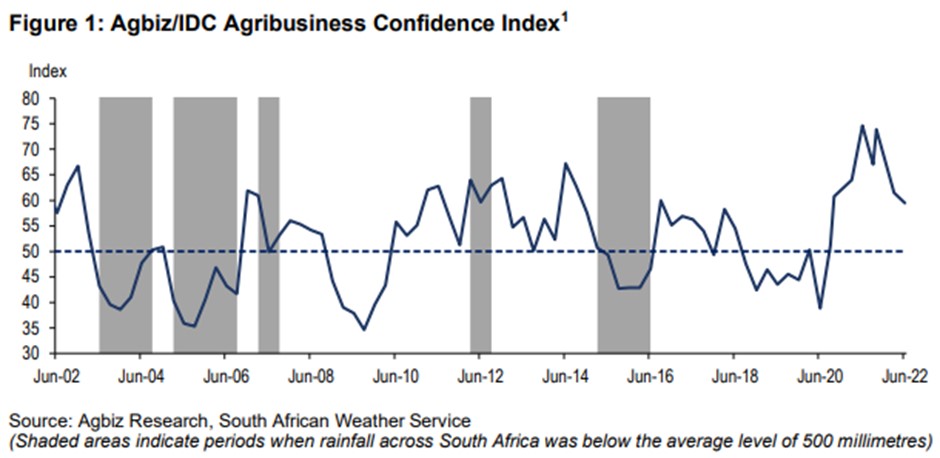
The ACI is comprised of ten subindices, of which eight declined in the second quarter of this year. The turnover subindex lifted by 7 points 93, while the net operating income subindex remained unchanged at 79 points. The lifted turnover is mainly due to higher agricultural commodity prices and the expected decent harvest in field crops and horticulture.
The market share of the agribusiness’s subindex fell by 5 points from the first quarter of 2022 to 71. The agribusinesses in horticulture, agricultural machinery and financial services were among the first respondents who signalled weaker expectations. However, most of the respondents maintained a broadly unchanged view from the previous quarter.
The employment subindex confidence increased by 5 points from the first quarter of 2022 to 73 in Q2 2022. This is unsurprising as the second quarter of the year is relatively busy with the harvesting of both summer crops and various horticulture products.
Confidence in the capital investments subindex increased with 6 points which is a pleasant surprise compared to the first quarter’s decrease of 13 points. It currently stands at 73 points. These are encouraging results at a time when farm input costs are rising and adding pressure on farmers and agribusinesses. An important signal of this activity is the tractor and combine harvester sales, which have remained positive for the first five months of this year. This comes on the back of two years of already solid sales growth.
The subindex measuring the volume of exports sentiment declined by 6 points from the first quarter to 71. This is reflects the expected decline in summer crop and wine grape harvests, as well as the temporary stoppage of livestock product exports because of the outbreak of foot-and-mouth disease. That said, a level of 71 still indicates robust export conditions.
Confidence in the general economic conditions fell by 5 points to 43. This reflects the uncertainty in the current geopolitical environment, inflation concerns, a general slowdown in the global economy, and more domestic events such as load-shedding, amongst other factors.
The general agricultural conditions subindex fell by 6 points to 54 in the year’s second quarter. The continued rains that slightly delayed the summer crop harvest might have influenced the respondents’ views here, along with delayed rains in the Western Cape for winter crops. Nevertheless, this subindex is still well above the 50-neutral mark, which shows that the sentiment about agricultural conditions in the country is broadly positive.
The debtor provision for bad debt and financing costs subindices are interpreted differently from the abovementioned indices. A decline is viewed as a favourable development, while an uptick is not a desirable outcome as it indicates that agribusinesses are financially constrained. In Q2 2022, the indices for debtor provisions for bad debt and financing costs fell by 2 and 14 points to 43 and 4, respectively. This is broadly favourable and reflects the tail end of the farmers’ financial gains of the last two robust seasons, which enabled them to service their debts. Still, the rising input costs and expected interest rate increases are aspects that most respondents flagged as crucial concerns.
In conclusion, Wandile Sihlobo, chief economist at Agbiz, said that the second-quarter results present a picture of a sector that is still on solid footing, but we still face numerous risks. The issues which are most concerning right now are the rising fuel, fertiliser and agrochemicals costs, which will pressure farmers and agribusinesses in the coming months. The ongoing war between Russia and Ukraine and the disruptions this has caused on some of our key fruit export markets and supply chains are also a major concern for the sector. However, some of our long-term challenges are within our reach as South Africans. These include the need to improve the efficiency of ports, electricity supply and water, quality of roads, curbing crime that devastates the rail network, and improving biosecurity. Addressing these aspects would have a far more positive impact on the long-term growth of this sector and, subsequently, job creation.
Source: www.agbiz.co.za, Issued by Wandile Sihlobo, chief economist: Agbiz
Weather and climate
NATIONAL ASSESSMENT
The long-term rainfall outlooks for:
- Summer rainfall areas are for below-average rainfall until about October, followed by above-average rainfall from about November 2022 to January 2023 (impact of both La Niña and the Indian Ocean.
- Winter rainfall areas will be about average until October with sporadic dry spells.
As seen in the graphs below, in early-August, sea surface temperatures (SSTs) in the central-eastern equatorial Pacific remain below average. Key oceanic and atmospheric variables have remained consistent with La Niña conditions, although weakened. A La Niña alert is active, meaning there is a 70% chance of La Niña returning later in 2022, three times the normal likelihood.
La Niña is favoured to continue through 2022 with the odds for La Niña decreasing into the Northern Hemisphere late summer (60% chance in July-September 2022) before increasing through the Northern Hemisphere fall and early winter 2022 (62% to 66% chance).
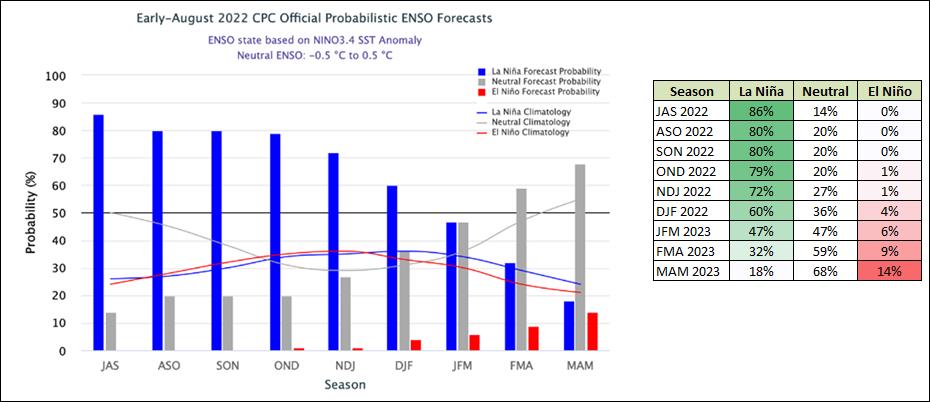
A large majority of the models in the plume predict SSTs to remain below normal at the level of a weak La Niña until at least Sep-Nov 2022. Neutral ENSO SSTs are between -0,5°C and 0,5°C. The current SSTs for September to January range from -0,8°C to -0,6°C.

The tables below reflects the movement of the eight ENSO indicators. The table will be included in the report for the months August to February when rainfall patterns are more relevant for the planting season. Since the table was last inserted most of the indicators remained the same – favourable of a La Niña.

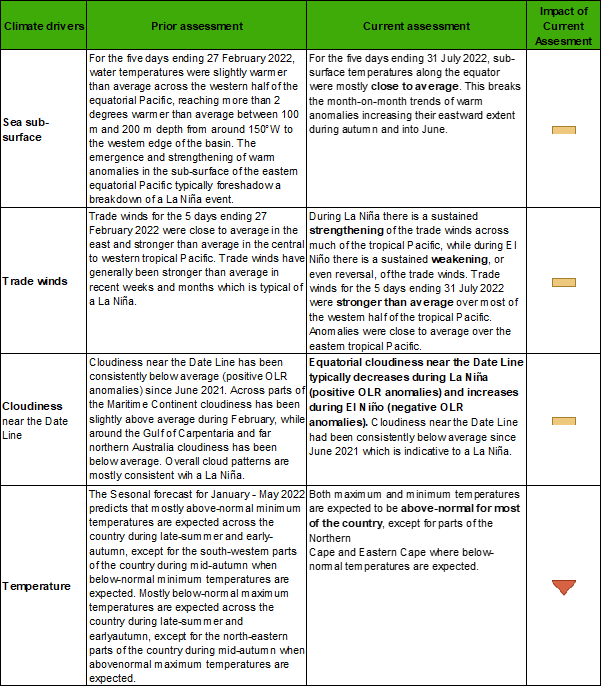
While back-to-back La Niña events are not uncommon and have occurred in approximately half of all past events since 1900, three in a row is less common and has only occurred three times since 1900: 1954 to 1957; 1973 to 1976 and 1998 to 2001.
Despite the end of the 2021/2022 La Niña, the bureau’s long-range climate outlook remains wetter than average for most of Australia, reflecting a range of climate drivers including a developing negative Indian Ocean Dipole, and warmer than average waters around Australia. South Africa is situated far from the Pacific Ocean where most of these analyses take place, but it is also situated in the southern hemisphere which is why Australia is used as a benchmark.
Source: http://www.bom.gov.au/climate/enso/#tabs=Pacific-Ocean&pacific=Sea-surface
In summary, most of the indicators favour a La Niña season with above-average rainfall predicted for the rest of 2022. Good rainfall is pivotal for agriculture, but correct timing is of the essence. Late rainfall earlier this year had a negative impact on the production season as too wet conditions hindered farmers from getting into their land in time to harvest. The wet conditions also caused a lower grade of grain to be produced. Sclerotinia flourishes in cold and wet conditions and as a result, sclerotinia infects sunflower crops causing major damage. Therefore, good rainfall is welcomed, but the timing is of the utmost importance.
Market risk
GRAIN MARKET ANALYSIS
- Ending stock – national
Ending stock data is gathered from the NAMC. The estimates are reassessed and reported by the Grain and Oilseeds Supply and Demand Estimates Committee. The following is a summary of the April 2023 projected final ending stock for the 2022/2023 season in tonnages:
- White maize => 1 116 119 t
- Yellow maize => 778 872 t
The following is a summary of September 2022 ending stock estimates for the 2021/2022 season:
- Wheat => 694 839 t
The following is a summary of February 2023 estimated ending stock for the 2022/23 season:
- Sunflower => 71 770 t
- Soybeans => 347 087 t
- Sorghum => 74 452 t
The graph below for white maize shows the estimated ending stock for white maize in April 2023, which is 349 338 tons or 24% less than the 2021/2022 season.
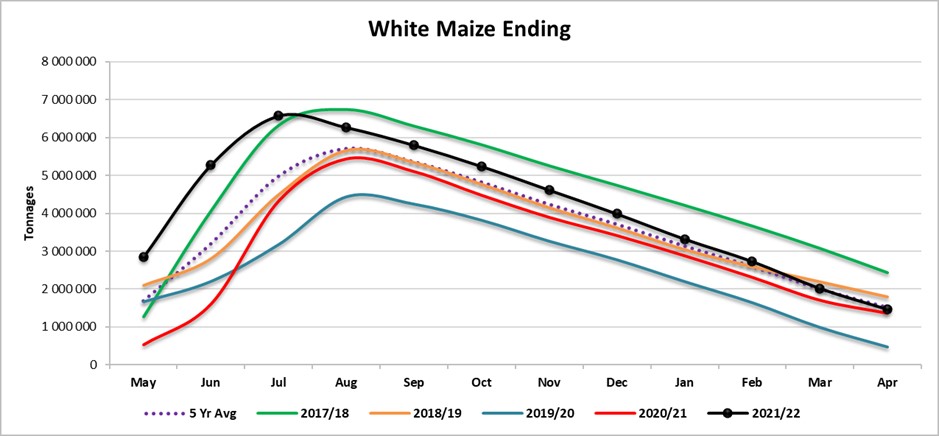
Source: Sagis
Yellow maize shows an estimated 120 190 tons or 18% increase in ending stock compared to the previous season – see graph below.
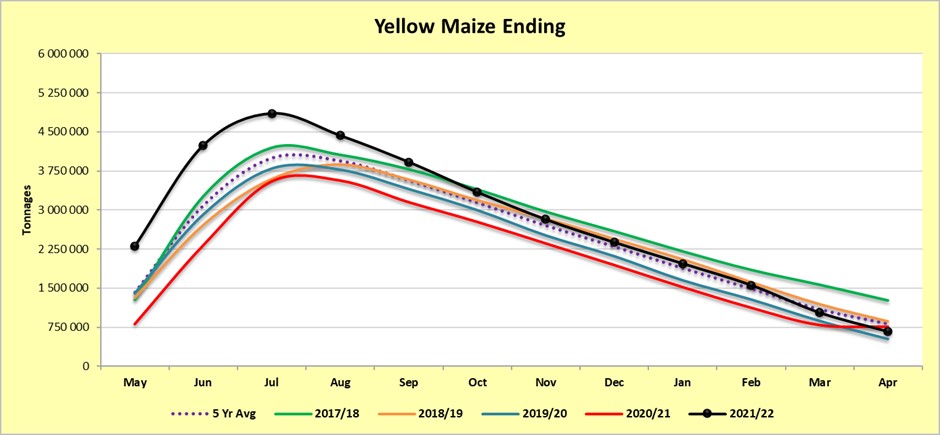
Source: Sagis
The estimated soya ending stock for February 2023 is 106% (178 700 tons) more than February 2022.
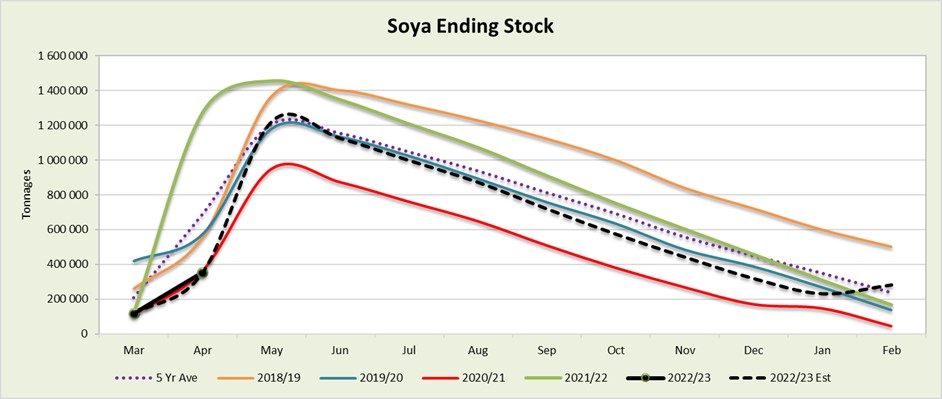
Source: Sagis
The estimated sunflower ending stock is 125% (39 980 tons) more than the previous season ending stock.
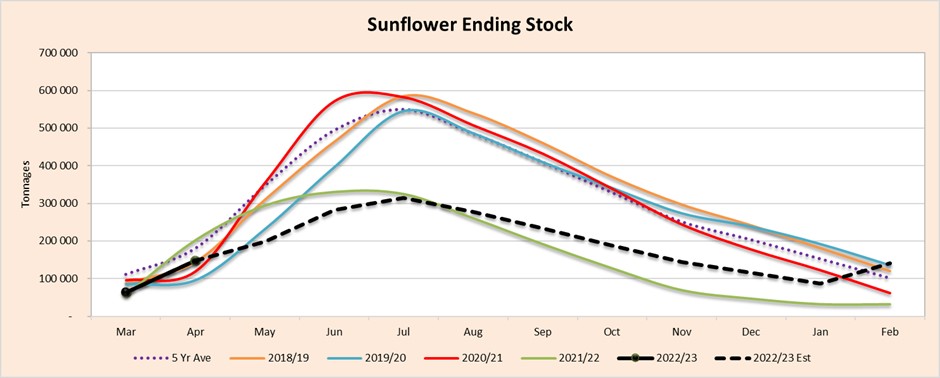
Source: Sagis
- Crop estimations
According to the Crop Estimate Committee (CEC), the preliminary area estimate for maize is 2,623 million hectares, which is 5% less than the actual 2,755 million hectares planted for the previous season.
- For the seventh forecast, the preliminary area estimate for white maize is 1,575 million hectares, which represents a decrease of 7% compared to the actual 1,692 million hectares planted last season. In the case of yellow maize, the area estimate is 1,048 million hectares, which is 1,5% less than the actual 1,064 million hectares planted last season.
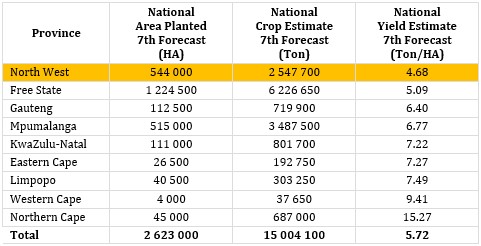
Source: CEC (Crop Estimates Committee)
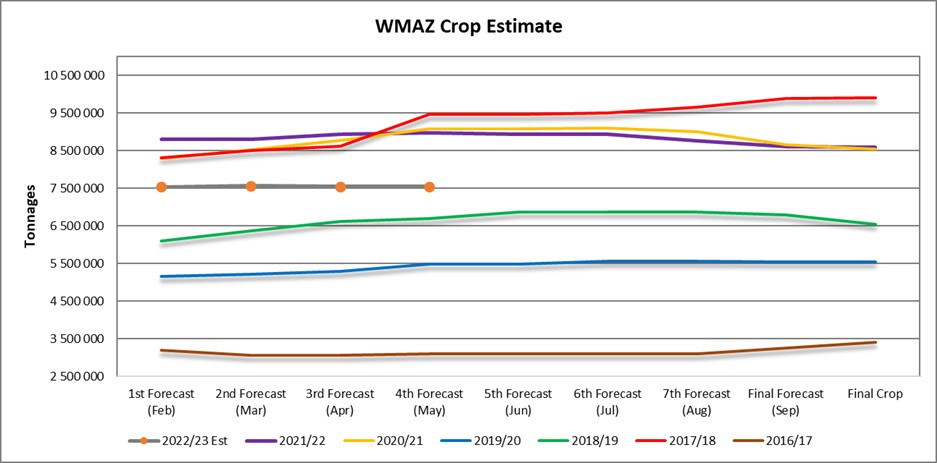
Source: CEC (Crop Estimates Committee)
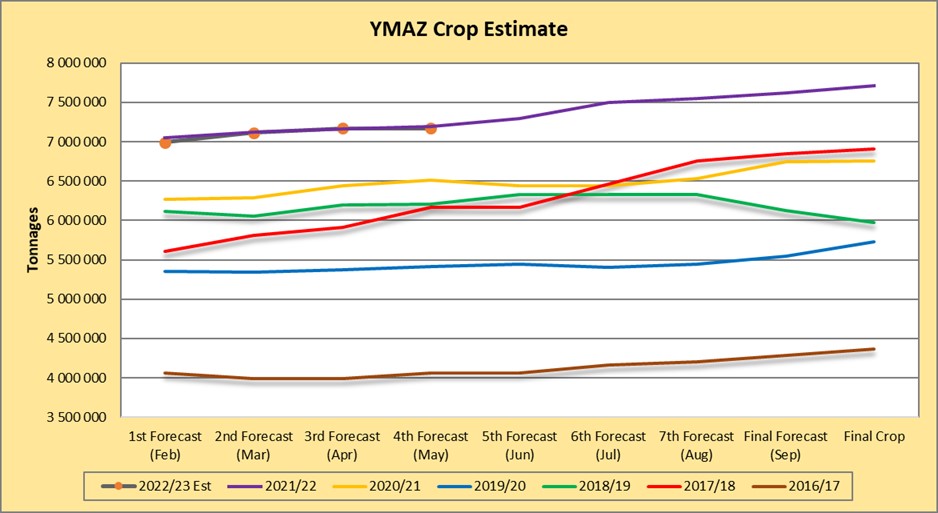
Source: CEC (Crop Estimates Committee)
The preliminary area estimate for sunflower seed is 670 700 ha, which is 40% more than the 477 800 ha planted the previous season.
It is estimated that 925 300 ha have been planted to soybeans, which represents an increase of 12% compared to the actual 827 100 ha planted last season. This is the highest soybean area planted in the history of South Africa.
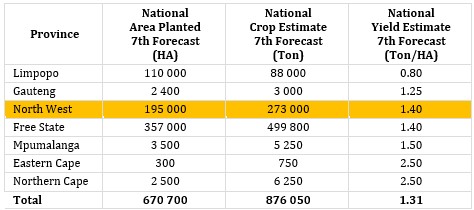
Source: CEC (Crop Estimates Committee)
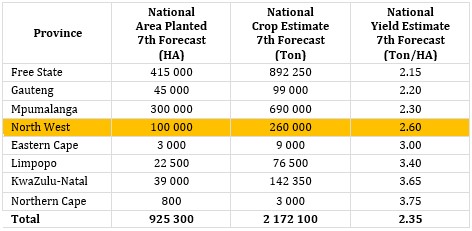
Source: CEC (Crop Estimates Committee)
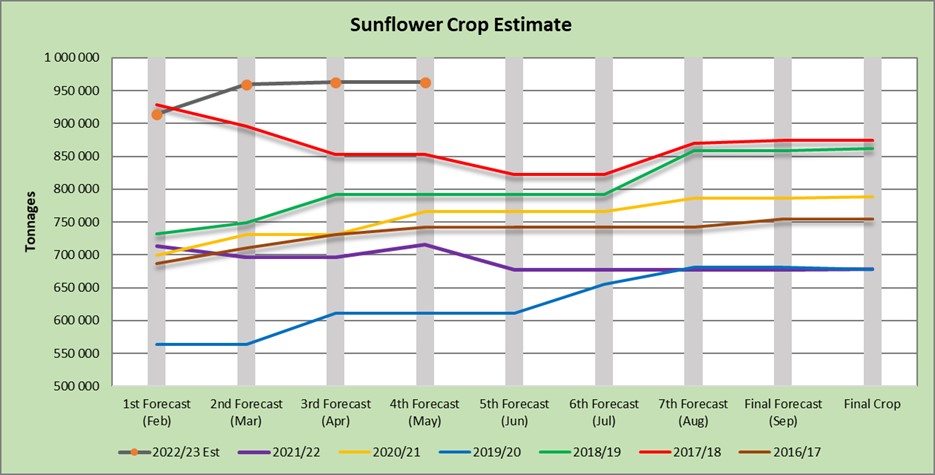
Source: CEC (Crop Estimates Committee)
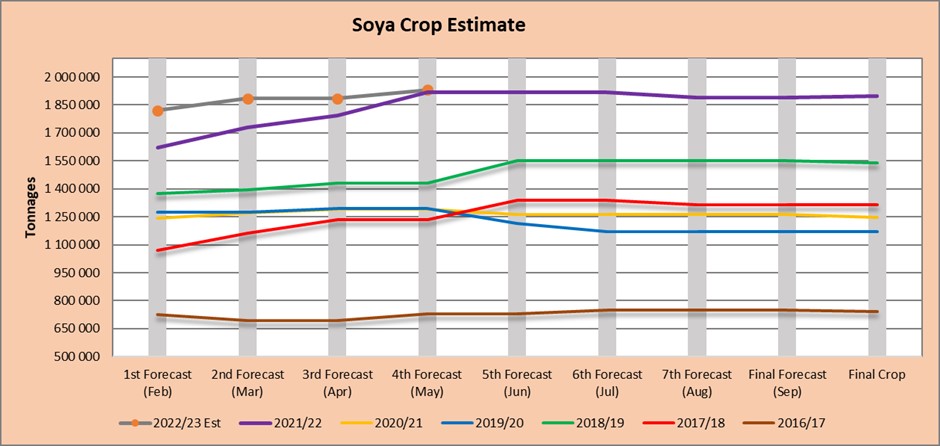
Source: CEC (Crop Estimates Committee)
- Imports and exports – national
For the production season ending April 2023, 217 161 957 tons of white maize and 1 227 225 tons of yellow maize have been exported to date as seen on the graphs below. In the previous season a record number of 2 991 129 tons yellow maize was exported. This was mainly due to South Africa’s competitive export parity prices compared to the rest of the world.
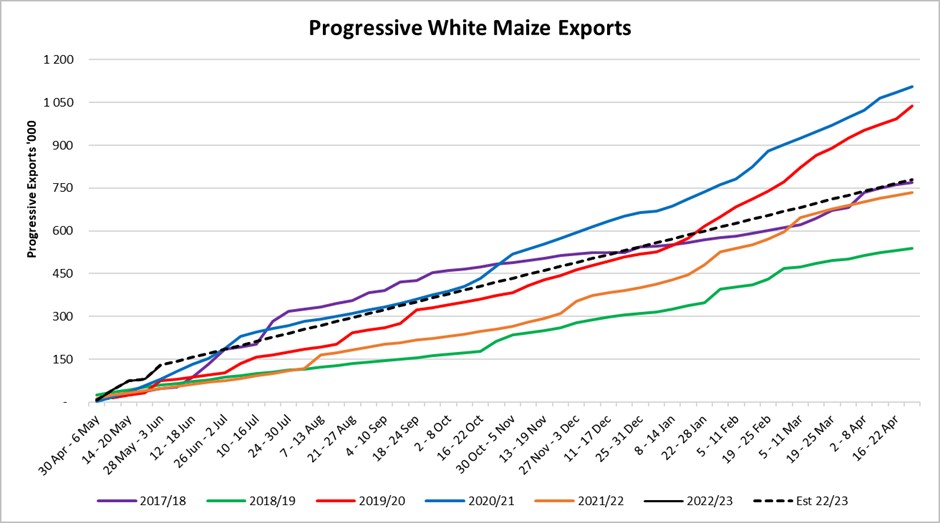
Source: Sagis
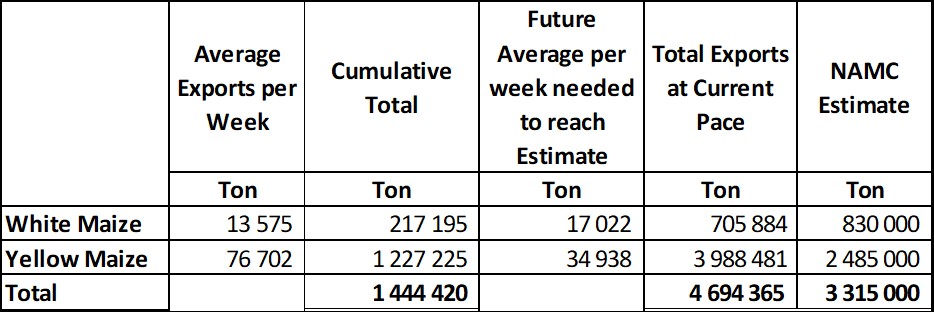
As seen in the table above, the average white maize exports per week are currently 13 575 tons. If theoretically, white maize exports remain at the current average per week then there would be 124 116 tons less white maize exports than anticipated.
The average yellow maize exports per week is currently 76 702 tons. If theoretically, yellow maize exports remain at the current average per week then there would be 1 503 481 tons more yellow maize exports than anticipated.
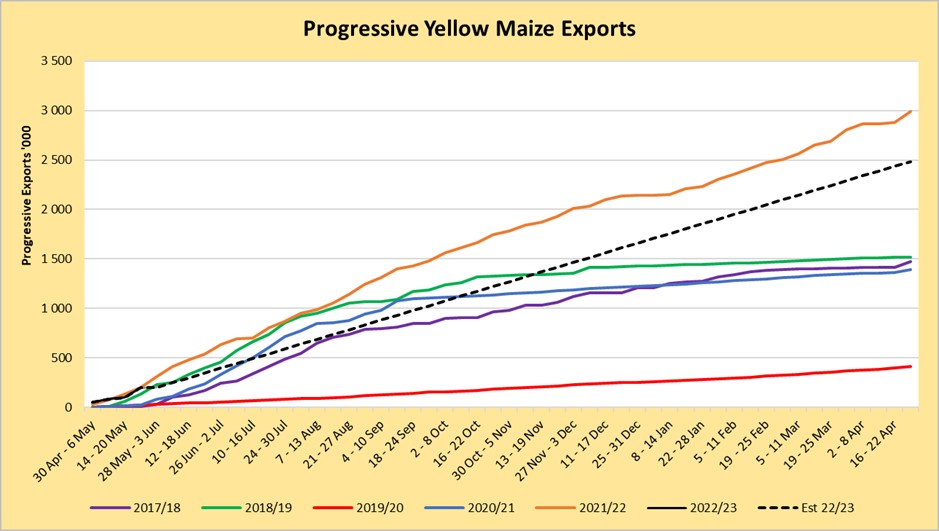
Source: Sagis
- Parity prices
South Africa is a small producer compared to other countries and is thus a price taker (meaning that we cannot influence world prices). Because of this, our local prices are normally between import and export parity, which is illustrated in the graph below. An import parity price is defined as the price which a buyer will pay to buy the product on the world market. This price will include all the costs incurred to get the product delivered to the buyer’s destination.
An export parity price is defined as the price that a local seller could receive by selling his product on the world market e.g., excluding the export costs. The price which the seller obtains is based on the condition that he delivers the product at the nearest export point (usually a harbour) at his own expense.
The graph below reflects the Safex price, import parity and export parity of yellow maize as well as the Safex price of white maize. The import and export parity prices for white maize is not released by Grain SA for this period.
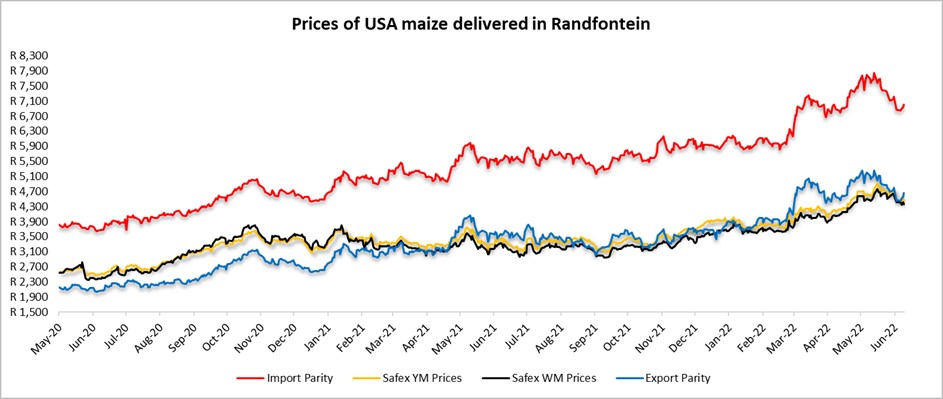
Source: Grain SA
- Producer deliveries – provincial
For the marketing year which is May to April the Free State dominates the white maize which is used for human consumption and gristing. The graph below shows that North West showed a significant increase for the 2020/2021 season with 1% compared to the previous season, but for the 2021/2022 season it decreased again with 17%.
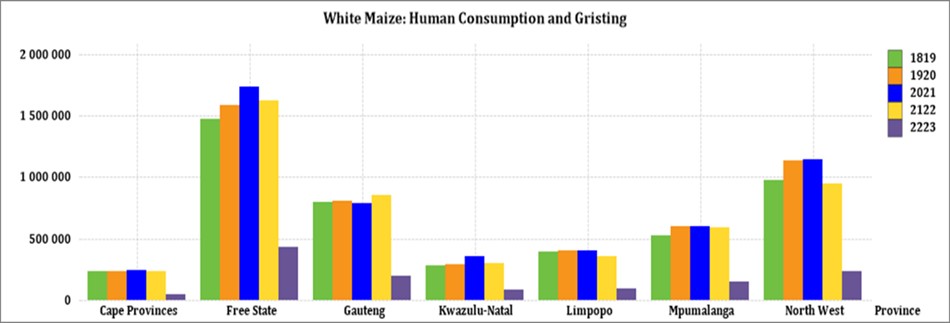
Source: Sagis
North West has a decreasing trend in yellow maize which is used for consumption and gristing. According to the graph below only 14 450 tons of yellow maize was used in the 2021/2022 season that ended April 2021. That is 22% less than in the 2020/2021 season.

Source: Sagis
- Exchange rate
NWK Group is exposed to foreign exchange rate risk on various business areas, such as commodity prices and trade imports.
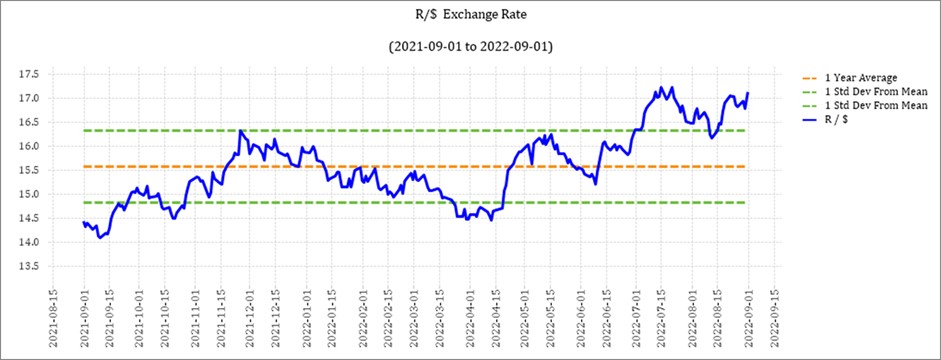
Source: Standard Bank, Corporate and Investment Banking & SARB
On a monthly average basis, the rand depreciated against the US dollar with 0,94% (R0,16) over the period July 2022 to August 2022. The one-year average for rand/US dollar is R15,57. Moreover, the average rand/US dollar exchange rate for the period August 2022 was R16,49 compared to R16,85 in July 2022. Since June the rand/US dollar exchange rate is once again higher than the first standard deviation from the mean.
Exchange rate forecast:
The graph below shows the actual USD/ZAR for 2021 Quarter 4 (Q4) and 2022 Quarter 1 (Q1) against the forecasted figures. The Economy Forecast Trading’s exchange rate forecast for 2022 Q1 was the closest to the actual exchange rate. According to Nedbank and The Enonomy Forecast Agency and Trading Economics the rand will weaken in the year 2022.
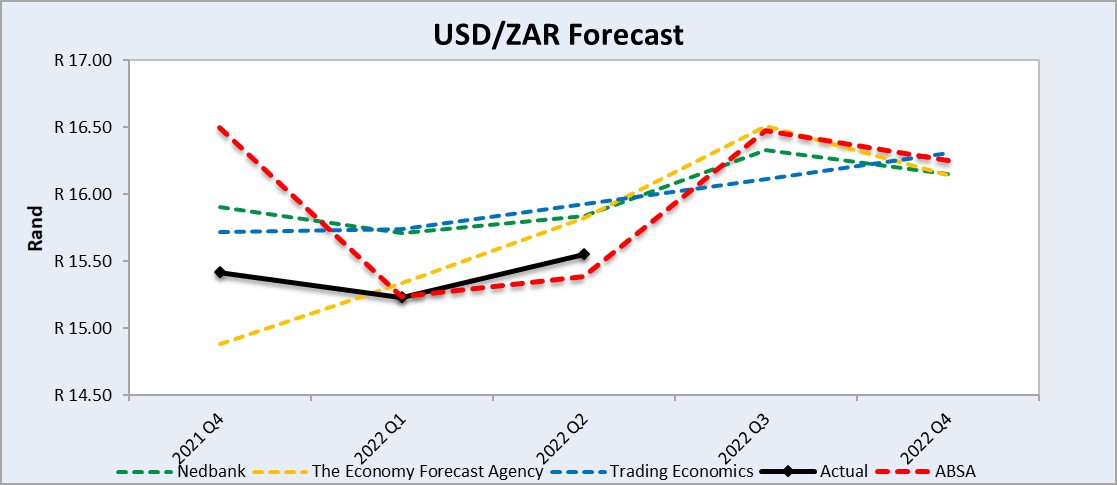
Source: Nedbank CIB; Absa; The Economic Forecast Agency; Trading Economics
Interest rate risk
On 27 March 2020, Moody’s downgraded South Africa’s sovereign credit rating to sub-investment grade and placed a negative outlook on the rating. The key drivers for this downgrade include weak economic growth, continuous deterioration in fiscal strength, and slow progress on structural economic reforms. It is now the first time in post-apartheid South Africa where all major rating agencies, i.e., Moody’s, Fitch and S&P, have South Africa’s credit ratings in sub-investment grade territory. More than a year later and our Moody’s rating remains the same.
The Covid-19 pandemic forced the South African Reserve Bank to make a number of interest rate cuts to bring relief to the economy, but as from November 2021 the prime interest rate experienced five increases. The latest increase of 75 bps is the biggest hike since 2002. Professor Raymond Parsons is of the opinion that given present global and domestic economic cross-currents, a more aggressive monetary policy raises the risk that it may well now come at a cost in growth and employment. The next MPC meeting date is 22 September 2022.
Interest rate movement:
- 18 November 2021: 7,25%
- 27 January 2022: 7,50%
- 24 March 2022: 7,75%
- 19 May 2022: 8,25%
- 21 July 2022: 9,00%
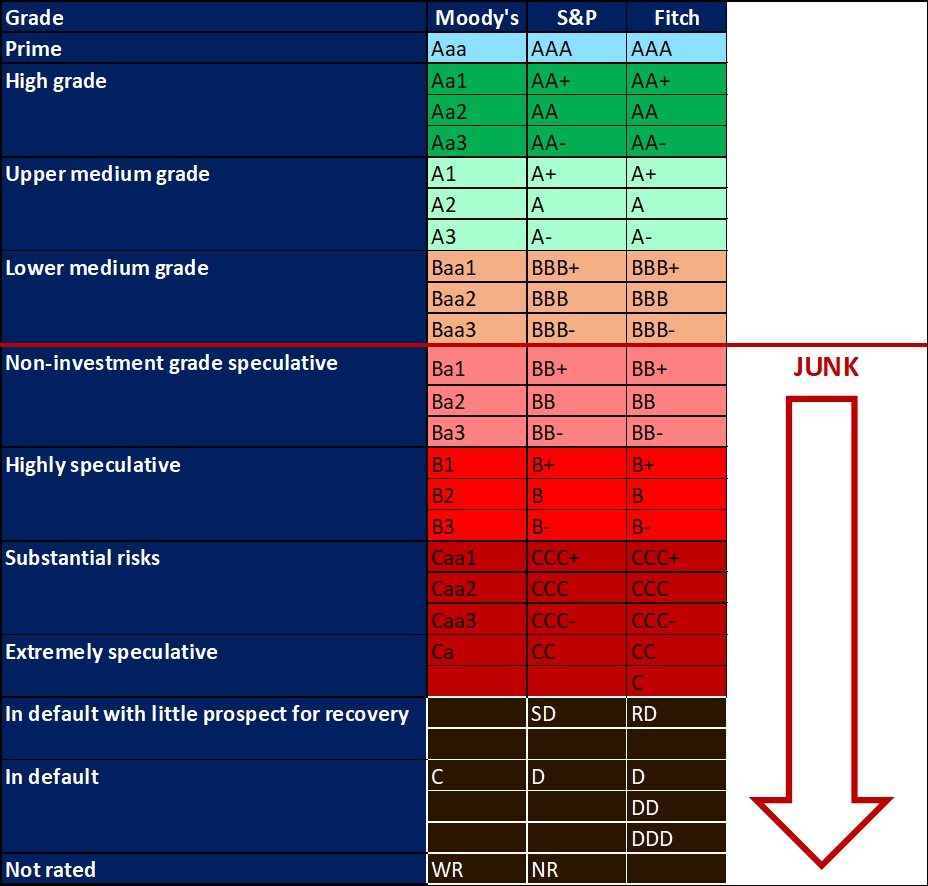
The graph below shows the prime rate forecast for 2022 Quarter 1 to 2022 Quarter 4. Nedbank as well as Trading Economics’ forecast that the prime interest rate will increase with 50 basis points by the end of Q2. The forecast realised on 19 May 2022 when the MPC increased the prime interest rate with a further 50 basis points. Both Q1 and Q2 experienced higher interest rates than anticipated by Nedbank and Trading Economics.
Prime rate
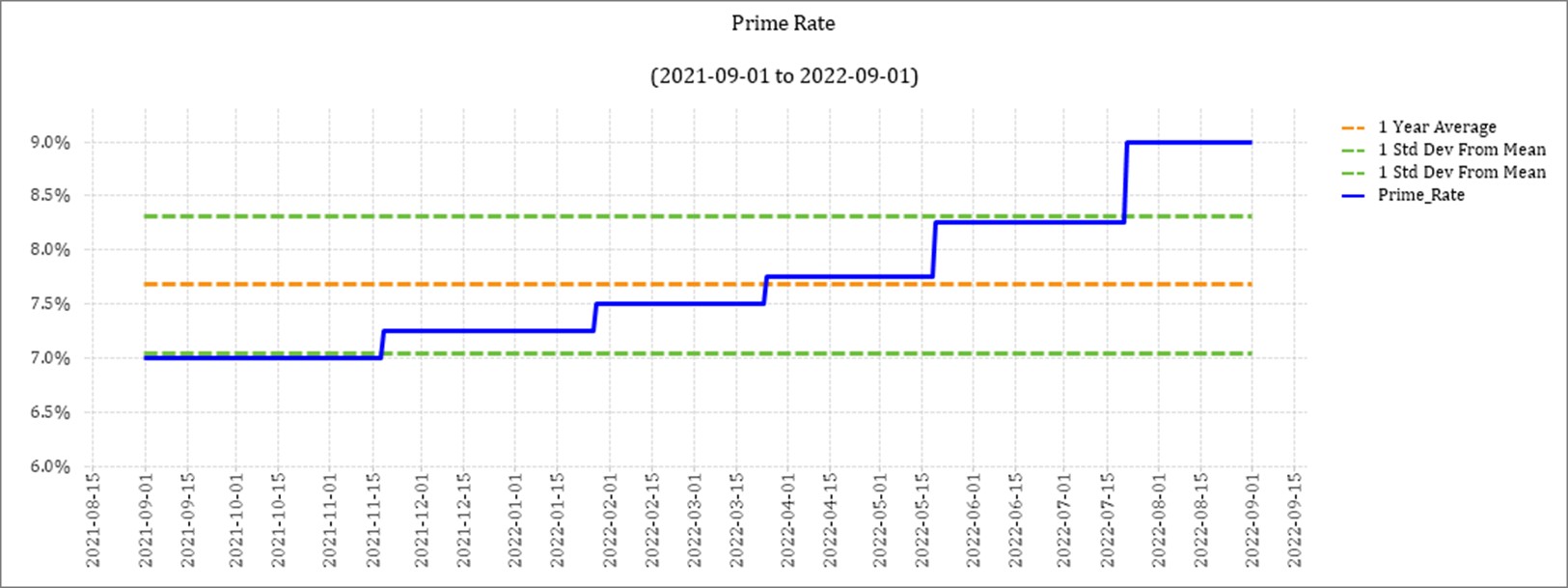 Repo rate
Repo rate
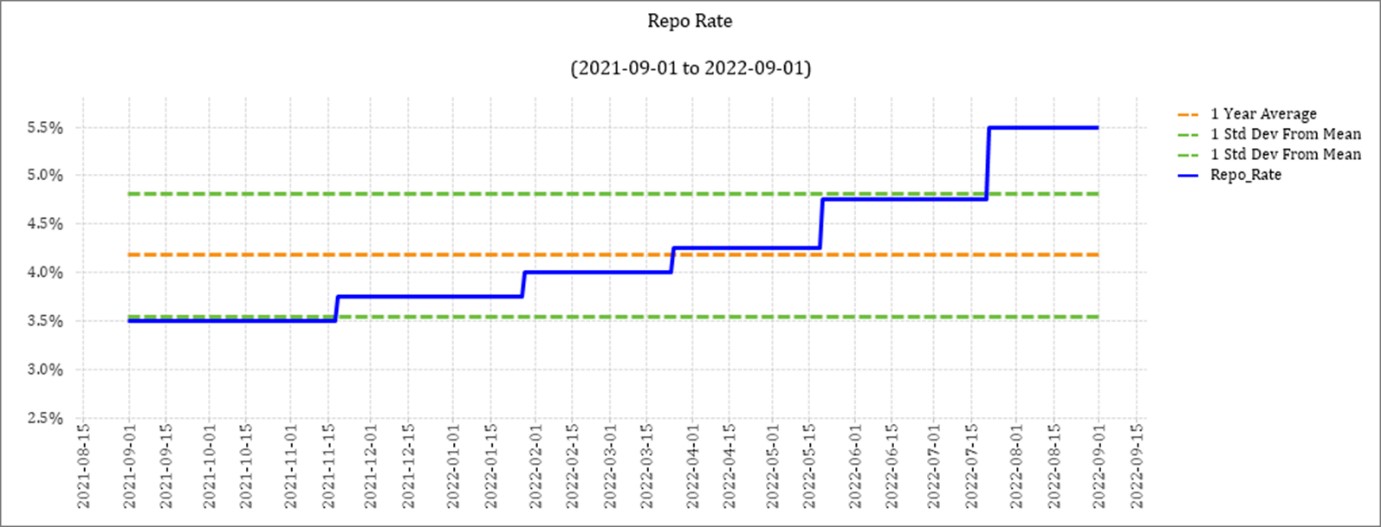
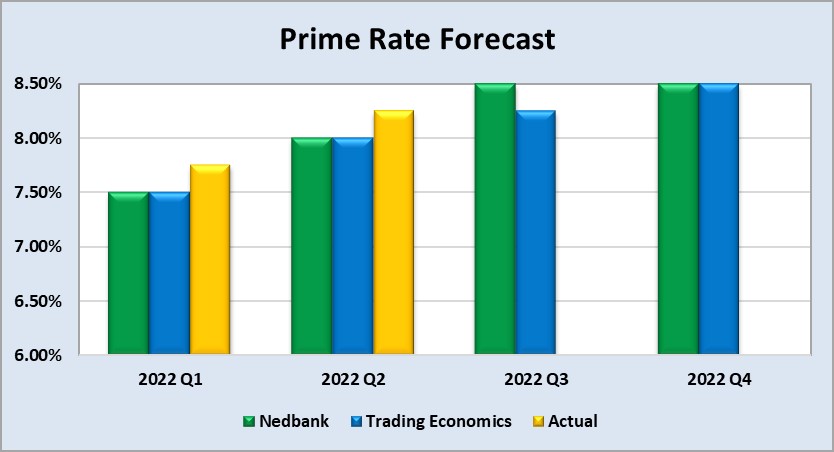
(CPI) Consumer Price Index
Currently, the South African consumer food price inflation hit the highest level since January 2017. The higher agricultural commodity prices that have been observed in the months since Russia invaded Ukraine, continues to filter into the food price inflation data. Moreover, the higher fuel price inflation since the start of the war is an additional cost driver of food prices.
The data released last week by Statistics South Africa show that in July 2022, the consumer food price inflation accelerated by 10,1% y/y, from 9,0% y/y in the previous month. This is the fastest pace since January 2017, which was a drought period in agriculture where costs were driven by higher agricultural commodity prices. The higher global grains and oilseed prices for much of the first half of this year have been the drivers of the costs of “bread and cereals” and “oils and fats” in the consumer food price inflation basket. These are also products with a relatively higher weight within the food basket. For example, within the food basket, the key products are meat (35%); bread and cereals (21%); milk, cheese, and eggs (17%); vegetables (8%); sugar, sweets and desserts (4%); oils and fats (3%); and fruit (2%).
The grains and oilseeds prices, which have been the major drivers of the surge in inflation, are starting to soften and this shows in the global indices. The price index averaged 140,9 points in July 2022, down by 9% from June. This was the fourth consecutive monthly decline, led by the drop in the prices of grains and oilseeds. These global developments are starting to show also in South Africa, and the lag could also reflect on the consumer food price inflation data in the coming months. Therefore, we suspect this might be a peak in the domestic food consumer price inflation.
Overall, as in the previous months, various factors in the South African food market will likely push in opposing directions in the coming months. Still, South Africa will likely remain an exception from the world, with food price inflation contained at relatively lower levels than most regions of the world. Importantly, the coming months could show moderation from the level we saw in July.
The table below shows the fluctuations from 2013 and the peak in 2017.
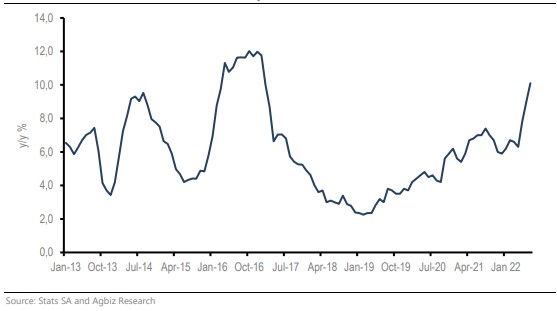
- Highlights in the agrochemical sector
On a month-to-month basis almost all of the products experienced price increases when looking at the prices in rand.
Herbicides
The following products are the main products regarding herbicides that may have an impact on input costs for producers:
- Glyphosate (95%)
- Acetochlor (92%)
- Atrazine (97%)
- Metolachlor (97%)
- Trifluralin (95%)
The following comparison is from the August 2022 Grain SA report which reports the previous month’s prices.
International herbicides prices, year to year change (R/t).

In comparison with the previous year’s prices, there was a significant increase in prices in four of the five main products. The only product that had a price decrease was Trifluralin with a decrease of -7.05%.
International herbicides prices – month to month change (R/t).

For the two months compared all five products experienced a price increase.
The graph below shows the international herbicides prices (R/t) per product from November 2019 to July 2022.
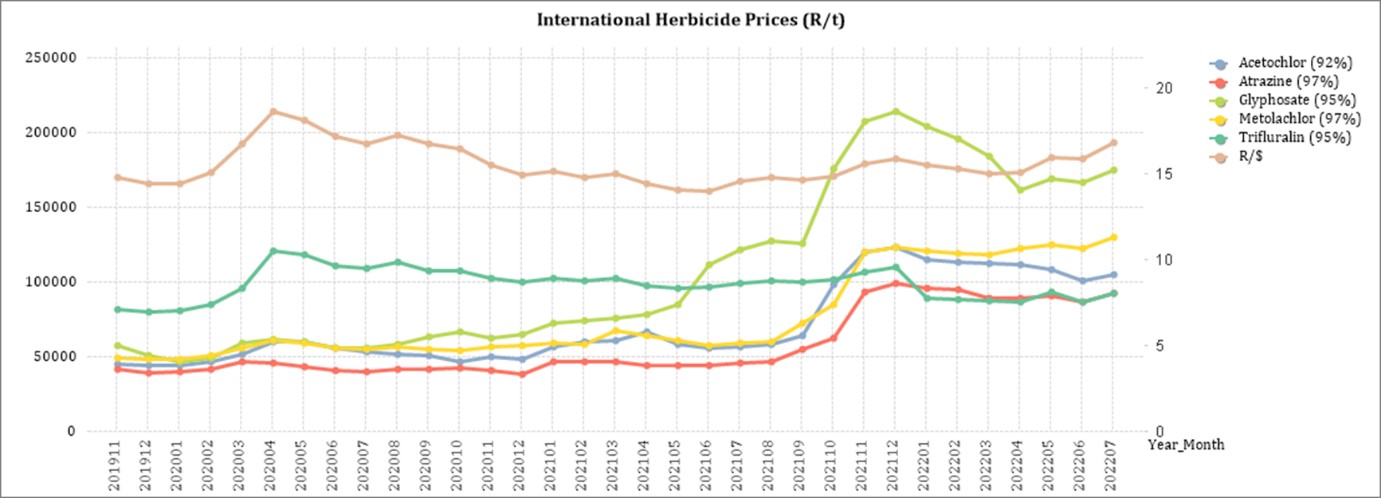
Insecticides
The following products are the main products regarding insecticides that may have an impact on input costs for producers.
Imidacloprid (95%)
Lambda-cyhalothrin (95%)
Carbofuran (99%)
Deltamethrin (98%)
Acetamiprid (95%)
Chlorpyrifos (95%)
Cypermethrin (94%)
Insecticides – year to year change (R/t): In comparison with the previous year’s prices, there was a noticeable increase in prices for four of the four main products. The largest increase was Acetamiprid with an increase of 47,74%.
International insecticide prices – year to year change (R/t).
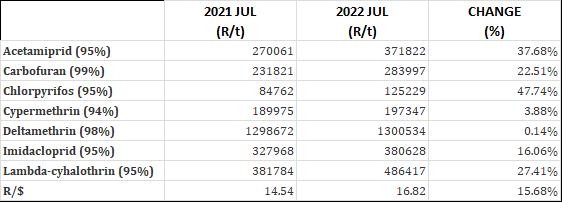
Insecticides – month to month change (R/t): All of the products experienced a price increase with Chlorpyrifos experiencing the biggest increase of 12,89%. The graph below shows the international insecticide prices (R/t) per product from November 2019 to July 2022.
International insecticide prices – month to year month (R/t).
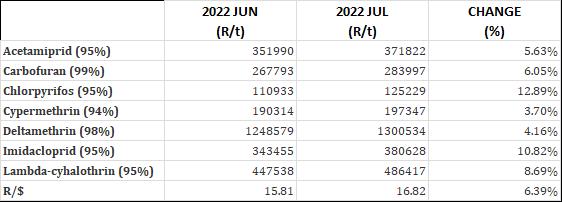
The graph below shows the international insecticide prices (R/t) per product from November 2019 to July 2022.

Fertiliser
The following fertiliser products are being analysed:
- Ammonia (Middle East)
- Urea (46%) (Eastern Europe)
- DAP (USA Gulf)
- KCL (CIS)
Urea market: The consensus view is that urea prices are to increase in the coming months but there is no common view on how high prices will go. August is likely to be a quiet month from a trading aspect / expected that serious demand will develop in September. Q4, the Northern Hemisphere seasonal stocking programme is to commence and this surge in buying usually supports prices which is the reason why fertiliser prices normally increase late in our SA fertiliser season. With European urea capacity idled due to high gas prices, many European buyers are anticipated to start buying early and in greater volumes than historically because they want to secure their required volumes.
According to F Curve Insights the outlook for urea prices remains bullish in the medium term as Q4 is historically a strong demand period, but it seems there may be further price reductions over the next couple of weeks until the Indian urea tender is issued. In their view, now is the time to buy urea if you have not already covered your urea requirements. They see urea rising steadily from September onwards for the rest of the year.
Ammonium nitrate market (AN): Prices are currently mostly flat this week. Supplies from most major production sites is good – ample availability at present. Prices will probably remain at current levels for the next month or so but as seasonal demand picks up in Q4, ammonia prices might increase again.
Phosphates: The outlook for phosphates remains bearish with prices predicted to keep losing a few dollars every week while demand remains poor and availability of product is not an issue. Prices continue to drift downwards as demand remains quiet, and the lack of phosphate availability from China is not sufficient to tighten the supply-demand balance. Demand for phosphates is non-existent in virtually all regions except for India. Chinese production continues to decline and domestic prices have fallen hundreds of dollars below international prices, so if the government permitted it, Chinese producers would resume exports quickly. This would add further downward pressure on prices.
Potash: The general market view is that potash is set for a steady decline over the coming six months, especially with the supply response expected from many of the other potash producers that was sparked by the predicted potash shortage resulting from sanctions on Russian and Belarussian exports. Lack of demand pushes Brazilian potash prices down. With potash prices falling in all markets around the world, the majority of buyers are postponing purchases as they wait for lower prices.
Source: https://www.grainsa.co.za/upload/report_files/Chemical-and-Fertilizer-Report_Aug-2022.pdf
International fertiliser prices – year to year change (R/t).

As seen in the table above all of the main fertiliser products increased significantly from July 2021 to July 2022. The biggest increase, based on average international prices (R/t), was KCL (127,06%), followed by Ammonia (78,42%), DAP (59,75%) and urea (24,88%).
International fertiliser prices – month to month change (R/t).

For the two months compared only two products experienced a decrease in price per ton.
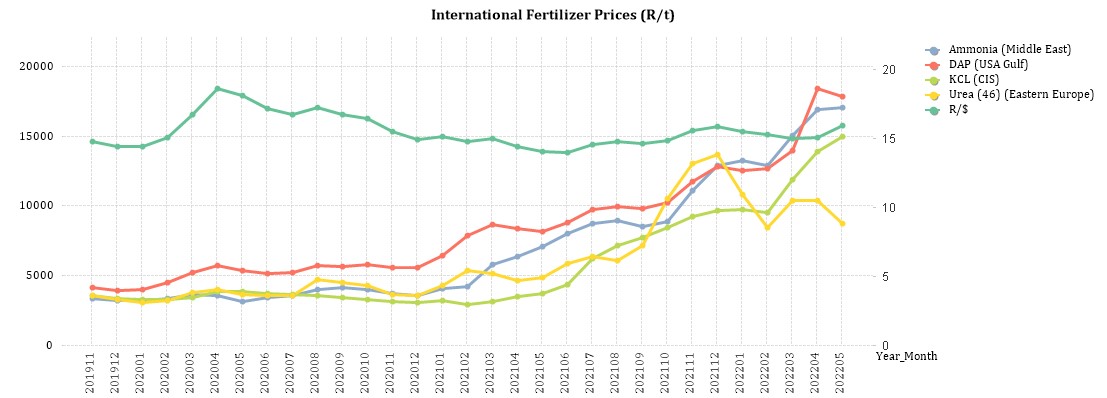
Sources: Grain SA – https://www.ft.com/content/4d746aa5-29e3-4796-b9e6-0b64c6865389
The graph above shows the international fertiliser prices (R/t) per product from November 2019 to July 2022.
- Economic impact of the Russia-Ukraine war
Impact on the broader economy
Despite South Africa’s special role with Russia via the BRICs (Brazil, Russia, India, China, and South Africa) grouping of middle-income countries, the South African government took a stronger stance, calling for Russia to withdraw its forces.
The invasion of Ukraine by Russia has a ripple effect on the world economy. Various countries will feel the short- and long-term effects of this war. Not all is however negative as a few possibilities arise in the short term.
For one, Ukraine is the biggest exporter of Sunflower oil followed by Russia. Russia also ranks first in the world for holding 24% of the world’s total natural gas reserves. Europe receives 30% to 40% of its total gas from Russia and it is going to be difficult to wean itself from Russia to loosen Vladimir Putin’s grip on European countries. Evidentially the price of sunflower oil and natural gasses increased as exports from Russia and Ukraine are backed-up. Brent crude oil recently reached $130 per barrel and analysts predict even further increases. European natural gas also jumped 62%. Despite this several other countries who are also suppliers of sunflower oil and natural gasses may benefit from this war as countries will have to look elsewhere for their usual imported resources.
International sanctions placed on Russia could place a growing demand on palladium as Russia is the world’s biggest producer of palladium with South Africa second. Palladium is a critical component in the manufacturing of automobiles and electronics. Similarly, Russia and South Africa are major exporters of gold and the South African rand has been strengthening as a result of rising global prices for the precious metal.
Despite these possibilities the attack on Ukraine could pose hardships for households, the agricultural sector and food security. The rising price of oil is causing fuel prices to increase and consequently lead to transport being a luxury. However, as from midnight, 6 September 2022, the following decline in prices will bring some relief to consumers.
Source: Business Tech
 Sources:
Sources:
Business Tech
https://www.cars.co.za/motoring-news/sa-fuel-prices-slashed-for-september-2022/132807/
https://businesstech.co.za/news/energy/622549/here-is-the-official-petrol-price-for-september-3/
- Future prices
The graphs below illustrate the market sentiment for maize, in the form of future contracts, for the upcoming contract months. The market sentiment is the expectation of supply and demand fundamentals relating to white and yellow maize in South Africa.
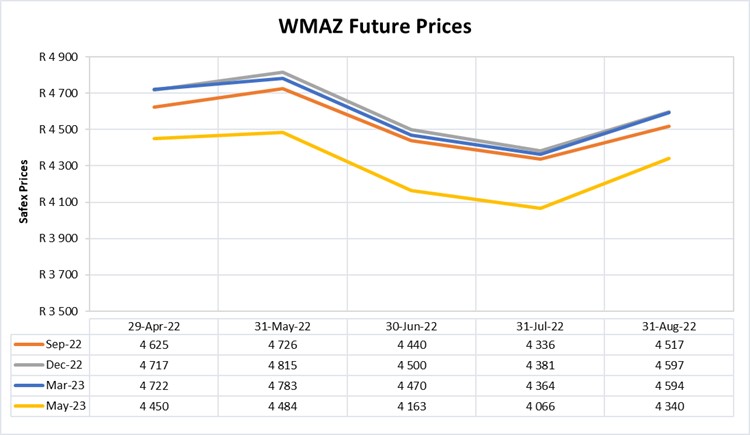
Source: Sagis/JSE

Source: Sagis/JSE
The decrease in WMAZ and YMAZ future prices are due to more supply during harvest season and the unfavourable exchange rate due to the strengthening dollar.
Impact of load shedding on the agricultural sector
Energy experts have warned that maintenance being done on Eskom’s ageing and failing fleet of power stations is ineffective – with the power utility itself admitting that it is only able to temporarily halt the decline. The reality is that load shedding will continue for years to come and the negative impact on the economy is severe.
Alexander Forbes chief economist Isaah Mhlanga said Eskom’s prolonged stage 6 load shedding has already caused significant damage to the country’s economy, with over R4 billion wiped from the GDP for each day it continues. Analysis by Bloomberg pointed out that at 2,276 gigawatt-hours cut by Eskom this year so far, South Africa is already at 90% of the gigawatt-hours cut in 2021 entirely.
The table below indicates the GDP lost per hour per sector due to load shedding:

From this table it is clear that the agricultural sector loses the most GDP per hour.
Modern farming businesses have become extremely dependent on electricity to run their irrigation, cooling, pumping stations, and mechanization. producers may need to find alternative power sources. These sources, while reliable, come at a cost. With increasing fuel costs as a result of the Russian-Ukrainian war and the big fuel consumption nature of generators, investing in a generator as a power source may not be a sustainable solution – especially for small-scale producers who are sensitive to increasing variable costs. When producers fail to find alternative sources, they take the risk of forfeiting water quotas for irrigating purposes which can cause the business to go under.
Machinery and equipment are damaged and repairment comes to a standstill as a result of power outages. producers may be forced to work after hours when there is electricity, leading to increased expenditure on overtime wages and increasing production costs. Some producers may not be able to afford this, given that production costs such as fertilizer and fuel have already increased a lot over the last few months.
When producers struggle, the agricultural sector is bound to feel the impact. A decline in production poses the biggest threat to the sector as it is, among other things, reliant on stock made available by producers. In summary, no yield means no stock in the silos and no income from millers. Not to mention the transport income, income from premiums received on commodities sold and the loss of sales in retail stores due to less expenditure by producers.
The producers’ production has a direct impact on their ability to repay loans. With increasing inflation and higher interest rates in South Africa, the repayment capacity of loans decreases and are less likely.
Decreased economic growth possible implications:
- Decreased foreign investment.
- Decreased sales – grain and retail.
- Increased operation cost (generator fuel cost).
- Decreased income from mechanisation.
- Weakening infrastructure.
- Inflation leads to higher input costs.
- Fluctuating and volatile markets.
- Decreased productivity and efficiency.
- Damage to electronic devices as power goes on and off.
- Increased theft.
- Overall increased risk and uncertainty.
According to Christo van der Rheede, Agri SA’s executive director, load shedding also poses a risk for food security and social stability.
In response to this energy crisis, Solidarity has appealed to everyone who is able to generate electricity on small scale to apply for power generating permits in an attempt to solve the electricity crisis. Regulations have been amended and up to 100 MW can be generated with a permit. However, a license is required when generating more than 100 MW.
In summary, load shedding poses long term risks for the agricultural sector on a supply and input cost level. Cost effective and sustainable alternative solutions must be considered in order to lighten the load on Eskom and reduce the dependency on Eskom for electricity.
Sources
https://businesstech.co.za/news/energy/602470/experts-give-bleak-outlook-for-load-shedding-in-south-africa-report/
https://maroelamedia.co.za/nuus/sa-nuus/tshwane-bekommerd-oor-beurtkrag-wipwaentjierit/
https://maroelamedia.co.za/nuus/sa-nuus/private-verskaffers-kan-kragrevolusie-veroorsaak/
https://www.chaifm.com/podcast/2022-07-06-christo-van-der-rheede
Fraud risk
FRAUD AWARENESS
Here are three fraud prevention tips:
Know who you’re dealing with. In any transaction you conduct, make sure to check with your state or local consumer protection agency and the Better Business Bureau (BBB) to see if the seller, charity, company, or organization is credible. Be especially wary if the entity is unfamiliar to you. Always call the number found on a website’s contact information to make sure the number legitimately belongs to the entity you are dealing with.
Pay the safest way. Credit cards are the safest way to pay for online purchases because you can dispute the charges if you never get the goods or services or if the offer was misrepresented. Federal law limits your liability to $50 if someone makes unauthorized charges to your account, and most credit card issuers will remove them completely if you report the problem promptly.
Guard your personal information. Crooks pretending to be from companies you do business with may call or send an email, claiming they need to verify your personal information. Don’t provide your credit card or bank account number unless you are actually paying for something and know who you are sending payment to. Your social security number should not be necessary unless you are applying for credit. Be especially suspicious if someone claiming to be from a company with whom you have an account asks for information that the business already has.



